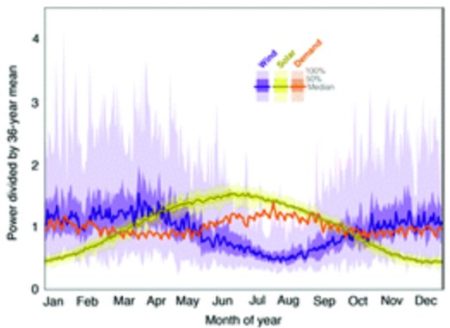Mar
7
Guessing the Price for 80% Wind and Solar For the US
March 7, 2018 | Leave a Comment
The ideas are about immense amounts of money and very likely, deeply understated.
According to scientists at the University of California, Irvine; the California Institute of Technology; and the Carnegie Institution for Science noted meeting 100% of electricity demand with only solar and wind energy would require storing several weeks’ worth of electricity to compensate for the natural variability of these two resources.
Steven Davis, UCI associate professor of Earth system science said, “The sun sets, and the wind doesn’t always blow. If we want a reliable power system based on these resources, how do we deal with their daily and seasonal changes?”
The team’s renewable energy study has been published in the journal Energy & Environmental Science.
The team analyzed 36 years of hourly U.S. weather data (1980 to 2015) to understand the fundamental geophysical barriers to supplying electricity with only solar and wind energy.
Davis said, “We looked at the variability of solar and wind energy over both time and space and compared that to U.S. electricity demand. What we found is that we could reliably get around 80% of our electricity from these sources by building either a continental-scale transmission network or facilities that could store 12 hours’ worth of the nation’s electricity demand.”
The researchers said that such expansion of transmission or storage capabilities would mean very substantial – but not inconceivable – investments. They estimated that the cost of the new transmission lines required, for example, could be hundreds of billions of dollars. In comparison, storing that much electricity with today’s cheapest batteries would likely cost more than a trillion dollars, although prices are falling.
Other forms of energy stockpiling, such as pumping water uphill to later flow back down through hydropower generators, are attractive but limited in scope. The U.S. has a lot of water in the East but not much elevation, with the opposite arrangement in the West.
Fossil fuel-based electricity production is responsible for about 38% of U.S. carbon dioxide emissions – CO2 production still being alleged in the press release as the major cause of global climate change. Davis said he is heartened by the progress that has been made and the prospects for the future.
“The fact that we could get 80 percent of our power from wind and solar alone is really encouraging,” Davis said. “Five years ago, many people doubted that these resources could account for more than 20 or 30 percent.”
The team’s effort suggests getting beyond the 80% mark, the amount of energy storage required to overcome seasonal and weather variability increases rapidly. “Our work indicates that low-carbon-emission power sources will be needed to complement what we can harvest from the wind and sun until storage and transmission capabilities are up to the job,” said co-author Ken Caldeira of the Carnegie Institution for Science. “Options could include nuclear and hydroelectric power generation, as well as managing demand.”
One has to instantly realize the team has made the case for either nuclear technologies or fusion technologies. Hundreds of billions of dollars for an assault of nationwide transmission lines that will immediately face the “not in my backyard syndrome”. These kinds of mandated things tend to double triple and likely even more as projects develop.
If history lessons are forever to be ignored the idea might gain some traction from those affected by central planned economy fantasies. But ask folks in the Northeast about running out of heat in the last storm from a lack of energy due to “planning” in green energy. Or check out the generation long Venezuela central planned socialization program results.
Its good to see some effort going into a fool’s errand to explore the unfathomable desire to find a silver bullet fix. The results are completely frightening.
Hundreds of billions in transmission lines? Check. Trillion or more for batteries? Check. Managing demand? Check. No guess at all for all the wind turbines and solar panels? Check.
Count this writer out.


